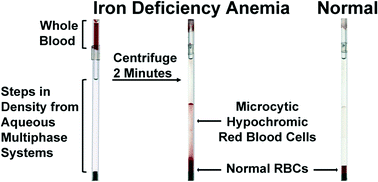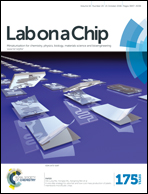Diagnosis of iron deficiency anemia using density-based fractionation of red blood cells†
Abstract
Iron deficiency anemia (IDA) is a nutritional disorder that impacts over one billion people worldwide; it may cause permanent cognitive impairment in children, fatigue in adults, and suboptimal outcomes in pregnancy. IDA can be diagnosed by detection of red blood cells (RBCs) that are characteristically small (microcytic) and deficient in hemoglobin (hypochromic), typically by examining the results of a complete blood count performed by a hematology analyzer. These instruments are expensive, not portable, and require trained personnel; they are, therefore, unavailable in many low-resource settings. This paper describes a low-cost and rapid method to diagnose IDA using aqueous multiphase systems (AMPS)—thermodynamically stable mixtures of biocompatible polymers and salt that spontaneously form discrete layers having sharp steps in density. AMPS are preloaded into a microhematocrit tube and used with a drop of blood from a fingerstick. After only two minutes in a low-cost centrifuge, the tests (n = 152) were read by eye with a sensitivity of 84% (72–93%) and a specificity of 78% (68–86%), corresponding to an area under the curve (AUC) of 0.89. The AMPS test outperforms diagnosis by hemoglobin alone (AUC = 0.73) and is comparable to methods used in clinics like reticulocyte hemoglobin concentration (AUC = 0.91). Standard machine learning tools were used to analyze images of the resulting tests captured by a standard desktop scanner to 1) slightly improve diagnosis of IDA—sensitivity of 90% (83–96%) and a specificity of 77% (64–87%), and 2) predict several important red blood cell parameters, such as mean corpuscular hemoglobin concentration. These results suggest that the use of AMPS combined with machine learning provides an approach to developing point-of-care hematology.


 Please wait while we load your content...
Please wait while we load your content...